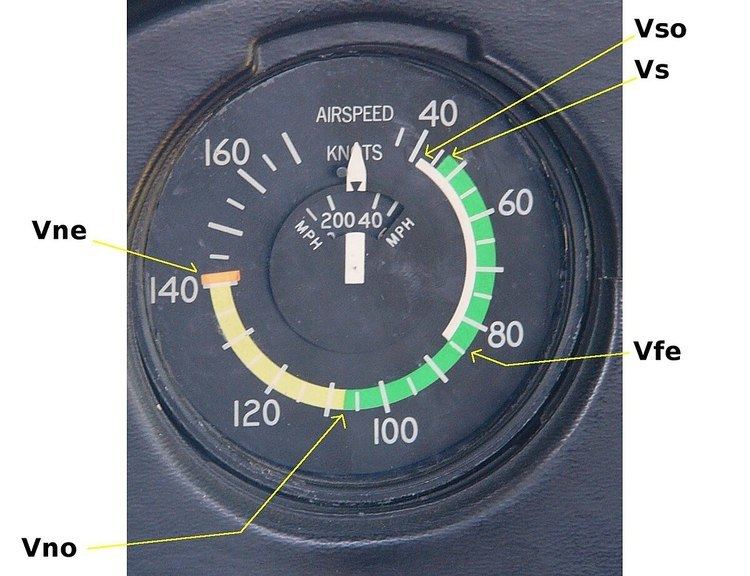 | ||
In aviation, V-speeds are standard terms used to define airspeeds important or useful to the operation of all aircraft. These speeds are derived from data obtained by aircraft designers and manufacturers during flight testing and verified in most countries by government flight inspectors during aircraft type-certification testing. Using them is considered a best practice to maximize aviation safety, aircraft performance or both.
Contents
The actual speeds represented by these designators are specific to a particular model of aircraft. They are expressed by the aircraft's indicated airspeed (and not by, for example, the ground speed), so that pilots may use them directly, without having to apply correction factors, as aircraft instruments also show indicated airspeed.
In general aviation aircraft, the most commonly used and most safety-critical airspeeds are displayed as color-coded arcs and lines located on the face of an aircraft's airspeed indicator. The lower ends of the green arc and the white arc are the stalling speed with wing flaps retracted, and stalling speed with wing flaps fully extended, respectively. These are the stalling speeds for the aircraft at its maximum weight. The yellow range is the range in which the aircraft may be operated in smooth air, and then only with caution to avoid abrupt control movement, and the red line is the Vne, the never exceed speed.
Proper display of V speeds is an airworthiness requirement for type-certificated aircraft in most countries.
Regulations
The most common V-speeds are often defined by a particular government's aviation regulations. In the United States, these are defined in title 14 of the United States Code of Federal Regulations, known as the Federal Aviation Regulations or FARs. In Canada, the regulatory body, Transport Canada, defines 26 commonly used V-speeds in their Aeronautical Information Manual (AIM). V-speed definitions in FAR 23, 25 and equivalent are for designing and certification of airplanes, not for their operational use. The descriptions below are for use by pilots.
Regulatory V-speeds
These V-speeds are defined by regulations. They are typically defined with constraints such as weight, configuration, or phases of flight, some of these constraints have been omitted to simplify the description.
Other V-speeds
Some of these V-speeds are specific to particular types of aircraft and are not defined by regulations.
Mach numbers
Whenever a limiting speed is expressed by a Mach number, it is expressed relative to the speed of sound, e.g. VMO: Maximum operating speed, MMO: Maximum operating Mach number.
V1 definitions
V1 is the critical engine failure recognition speed or takeoff decision speed. It is the speed above which the takeoff will continue even if an engine fails or another problem occurs, such as a blown tire. The speed will vary among aircraft types and varies according to factors such as aircraft weight, runway length, wing flap setting, engine thrust used and runway surface contamination, thus it must be determined by the pilot before takeoff. Aborting a takeoff after V1 is strongly discouraged because the aircraft will by definition not be able to stop before the end of the runway, thus suffering a "runway overrun".
V1 is defined differently in different jurisdictions:
